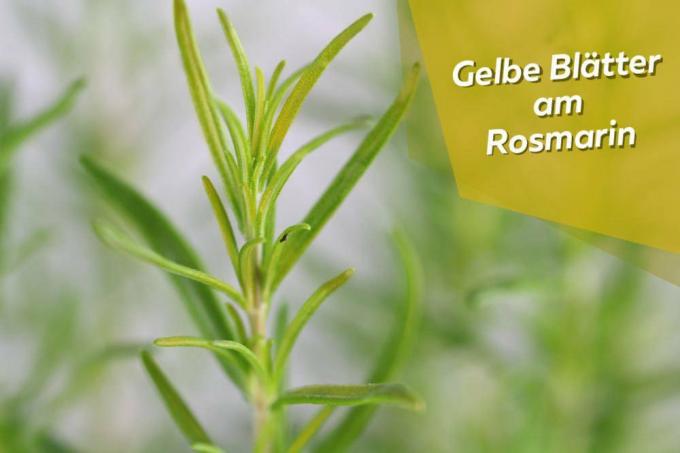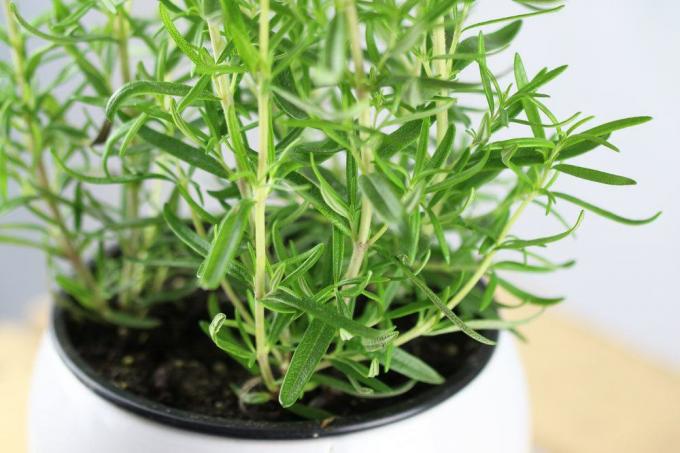
table of contents
- Rosemary gets yellow needles
- Rosemary dried up
- Do not rule out pest infestation
- Saving a dried out rosemary plant
- Preventive measures
- Pour properly
- Correct choice of location
- Be careful when mulching
- Fertilization only in an emergency
Rosmarinus officinalis - "dew of the sea" is represented in almost every herb garden in this country. Found in ancient times rosemary Use as a herb and medicinal herb. Even today it is mainly used in the kitchen. The mint can be planted in the garden or cultivated in a tub or on the windowsill. Usually the rosemary is quite easy to care for. However, there are a few things to consider, otherwise the plant can quickly be damaged.
Rosemary gets yellow needles
As a rule, isolated yellow needles are normal in rosemary, as in all other plants. There is nothing to worry about yet. At regular intervals, old leaves turn yellow and die. However, if several needles take on a yellow color and the otherwise Evergreen subshrubes form bald spots, then quick action is necessary to keep the plant still to rescue. It is now important to find out the causes of the discoloration. There are different ways of doing this
- Care errors
- wrong location
- incorrect fertilization or
- Pest infestation
In most cases the subshrub is just too wet. In other words, it is a mistake of care that the plant was made poured over.
Rosmarinus officinalis is native to the Mediterranean region. There it grows partly on barren soils, on sunny rocky slopes, where there is not much water. Most of the moisture it needs comes from the air. He "drinks" the morning dew.
In addition, it has a widely ramified root system that extends deep into the earth. This allows the plant to draw nutrients and water from great depths. This fact should always be taken into account when watering, because rosemary does not need a lot of water.
tip: A yellow discoloration of the needles on the rosemary are the first signs of too much moisture. The earth needs to dry and then less watering should be done.
The problem of "pouring over" occurs mainly when growing in pots and tubs. Here the Finger test be made. The earth should just feel damp, not wet. Furthermore, standing water in the coaster is always an indication of waterlogging. This is deadly for almost all plants. This can be remedied with a few measures
- Stop pouring
- Let the earth dry
- If necessary, repot in new and fresh substrate
- then water only moderately, if at all
If there is too much moisture, the leaves of the rosemary will usually first turn yellow and then brown and dry.
Rosemary dried up
Sometimes it can also be observed that the leaves of Rosmarinus officinalis turn brown and finally dry up. The watering can is then quickly reached to give the shrub moisture. But beware! Of course, the prevailing opinion here is that dried up leaves are a sign of a lack of water and the plant is now dying. However, in most cases too much was poured. In the case of free-range rosemary, it may be due to the nature of the soil, for example heavy soils store a lot of water. The result is waterlogging. If the error is not recognized, it will not take long and the rosemary will dry up. If you give too much water, the roots will eventually start to rot. As a result, water and nutrients can no longer be transported within the plant. The above-ground parts of the plant wither and dry up.
tip: If the rosemary droops the leaves, it indicates a lack of water. This can happen especially in hot summer months and warm winters. Be careful as soon as yellow needles appear, stop watering.
Do not rule out pest infestation
In addition to care errors that have already been carried out, pests should also be excluded as causes of yellow discoloration of the leaves and needles of rosemary. Therefore, the plants should be checked regularly for uninvited "visitors". Most of these are located on the underside of the leaves, are only a few millimeters in size and sometimes difficult to see with the naked eye. Damage can be caused by
- Spider mites
- Scale insects
- Thrips and also
- Run out of mushrooms.
Usually these occur at the end of winter when plants have been overwintered in the house. The causes can be as follows
- high temperatures
- low humidity
- dry heating air
Control should only be carried out with biological means, since the plant is intended for consumption. Most of the time, increasing the humidity or a garlic brew will help.
tip: Rosemary planted in the garden usually hardly needs any additional watering, only during prolonged and hot dry periods.
Saving a dried out rosemary plant
Sometimes the Rosmarinus officinalis can look dry even though it has been watered and the soil is not completely dry. In order to save him, an examination of the roots is necessary. It has to be acted quickly so that a rescue is still possible.
- Dig up rosemary in the open ground
- lift out of the pot when growing in a bucket
- Carefully remove soil at the roots
- Examination of the roots for rot
- Remove sick, dried out roots with a sharp knife
- Carry out a generous root cut
- Shower the remaining roots with warm water and dry them carefully
- Dip roots in rooting hormone
- prevents fungal growth
- choose a different location outdoors
- Use a new pot with fresh substrate and drainage layer when cultivating in pots
- Rosemary strong cut back, but not in the old wood
- Otherwise the plant will sprout again badly
- water regularly, but little
With a lot of luck, the dried up rosemary plant will sprout again. However, it will take some time

Preventive measures
Even when planting rosemary, certain measures should be taken so as not to cause one Later on you have to look for causes because the shrub is yellow and withered leaves receives. Among other things, you should consider various factors
- Watering
- Location
- fertilization
Pour properly
Watering is always very important with rosemary. You decide how this easy-care plant will thrive. You can't usually go wrong with the following if you keep the following in mind
- Mainly, water is absorbed through parts of the plants above ground
- always water from above, especially potted plants
- never leave water in the coaster (waterlogging)
- Roots should be as dry as possible
- Only pour when the surface of the substrate is dry
- The plant can dry out for a short time and is not damaged in the process
- Water more often on hot days, especially potted plants
- Outdoor plants need significantly less watering
- fetch water and nutrients from the depths via the branched root system
- water only in hot dry periods when needles are thrown off
- perform a finger test on potted plants
- Water young plants and cuttings regularly but moderately
- facilitates growth
Alternatively, you can also "dip" potted plants. To do this, take the plants out of the pot and place the root ball in a bucket with water. Then drain well. This method is also good for dried out plants on hot days.
tip: For new plantings you can count on three to five liters of water per bush. Depending on solar radiation and rainfall, this watering takes place once a week for the first three to four weeks. Then reduce the amount of water given.
Correct choice of location
The “dew of the sea” needs a suitable location for healthy growth. In doing so, he makes some demands on the floor. He loves
- Sun
- rather poor, sandy, dry and well-drained soil
- neutral to alkaline pH
Heavy and loamy soils are more of a poison for the evergreen shrub. These store a high proportion of water. Waterlogging quickly occurs and consequences as already described can occur. A location on stone walls or in pebble beds in the vicinity of thyme, lavender or oregano, plants that have the same care needs would be ideal.
Be careful when mulching
The herb bed is also mulched, usually with bark mulch. Caution is advised here, because the Mediterranean plant does not like an additional layer of mulch. Particularly Bark mulch stores moisture. As a rule, the herb would then stand too wet. It would be better to adjust the conditions to those of the Mediterranean homeland. Instead of bark mulch, gravel, coarse gravel or small pebbles can be used here.
Fertilization only in an emergency
Sometimes overfertilization or lack of nutrients can also cause plants to turn yellow. This evergreen shrub does not require additional nutrients. It has a deep and widely branched root system. This means that nutrients and water can still be fetched from very deep layers of the earth. In order to stimulate growth a little, organic fertilizers such as compost or horn meal can be given sparingly every spring. Potted plants should only be fertilized very little if they are not repotted.


